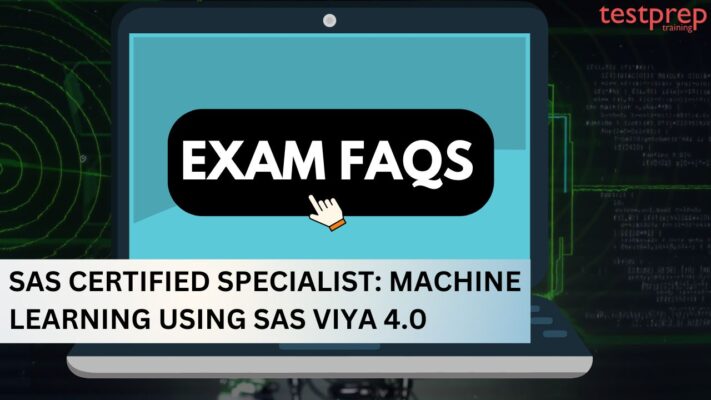SAS Certified Specialist: Machine Learning Using SAS Viya 4.0
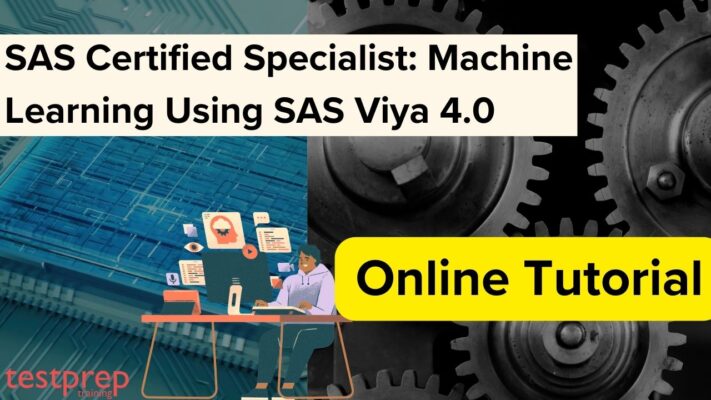
SAS Certified Specialist: Machine Learning Using SAS Viya 4.0 certification validates your ability to build and deploy supervised machine learning models using SAS Viya. It’s ideal for data scientists and analysts who want to demonstrate their expertise in this specific area.
Exam Details
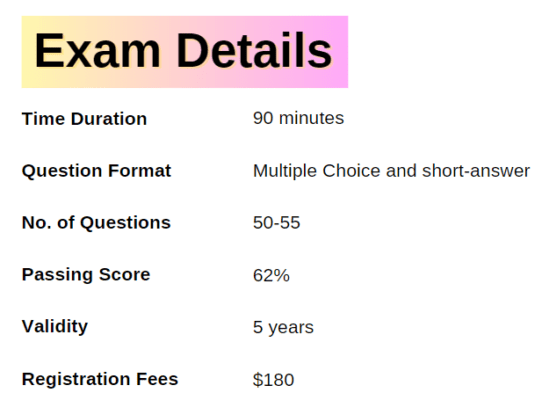
- The SAS Certified Specialist: Machine Learning Using SAS Viya exam, jointly administered by SAS and Pearson VUE, consists of 50-55 multiple-choice and short-answer questions.
- Candidates are allotted 90 minutes to complete the exam, with a passing score set at 62%.
- Certification earned from this exam is valid for 5 years, and it is centered around SAS Viya 4.0.
- The exam fee in the US and most other countries is $180.
Registering for the exam
1. Create a Pearson VUE account:
- Visit the Pearson VUE website.
- Click on “Create an Account” and follow the prompts to register.
- Make sure to remember your login credentials as you’ll need them later.
2. Schedule your exam:
- Once logged in to your Pearson VUE account, search for the exam using its ID: A00-406.
- Select your preferred testing location and date/time based on availability.
- Review the exam details and fees carefully before proceeding.
- Pay the exam fee using a credit card or other accepted payment method.
- Confirm your registration and note down your confirmation number for future reference.
Course Outline
The following objectives will be tested on the SAS Certified Specialist: Machine Learning Using SAS Viya 4.0 exam.
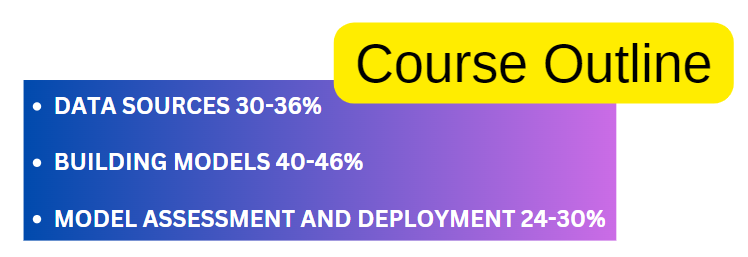
Understand Data Sources (30 – 36%)
Creating a project in Model Studio
- Bringing data into Model Studio for analysis
- Importing data from a local source (Import tab)
- Adding data from a stored data source (Data Sources tab)
- Using an in-memory data source (Available tab)
- Creating Model Studio Pipelines with the New Pipeline window
- Automatically generate pipelines
- Pipeline templates
- Advanced Advisor options
- Maximum class level
- Maximum % missing
- Interval cut-off
- Partition data into training, validation, and test
- Explaining why partitioning is important
- Understanding the different methods to partition data (stratified vs simple random)
- Using Event Based Sampling for rare events.
- Setting up Node Configuration
Exploring the data
- Using the DATA EXPLORATION node
- Profiling data during data definition
- Preliminary data exploration using the data tab
- Saving data with the SAVE DATA node
Modifying data
- Explaining concepts of replacement, transformation, imputation, filtering, outlier detection
- Modifying metadata within the DATA tab
- Modifying metadata with the MANAGE VARIABLES node
- Using the REPLACEMENT node to update variable values
- Utilizing the TRANSFORMATION node to correct problems with input data sources, such as variables
distribution or outliers - Using the IMPUTE node to impute missing values and create missing value indicators
- Preparing text data for modeling with the TEXT MINING node
- Explaining common data challenges and remedies for supervised learning
Utilizing the VARIABLE SELECTION node to identify important variables to be included in a predictive model
- Unsupervised Selection
- Fast Supervised Selection
- Linear Regression Selection
- Decision Tree Selection
- Forest Selection
- Gradient Boosting Selection
- Create Validation from Training
- Use multiple methods within the same VARIABLE SELECTION node
Learn about Building Models (40 – 46%)
Describe key machine learning terms and concepts
- Data partitioning: training, validation, test data sets
- Observations (cases), independent (input) variables/features, dependent (target) variables
- Measurement scales: Interval, ordinal, nominal (categorical), binary variables
- Supervised vs unsupervised learning
- Prediction types: decisions, rankings, estimates
- Curse of dimensionality, redundancy, irrelevancy
- Decision trees, neural networks, regression models, support vector machines (SVM)
- Model optimization, overfitting, underfitting, model selection
- Describe ensemble models
- Explain autotuning
Building models with decision trees and ensemble of trees
- Explaining how decision trees identify split points
- Split search algorithm
- Recursive partitioning
- Decision tree algorithms
- Multiway vs. binary splits
- Impurity reduction
- Gini, entropy, Bonferroni, IGR, FTEST, variance, chi-square, CHAID
- Compare methods to grow decision trees for categorical vs continuous response variables
- Explaining the effect of missing values on decision trees
- Explaining surrogate rules
- Understanding the purpose of pruning decision trees
- Explaining bagging vs. boosting methods
- Build models with the DECISION TREE node
- Adjust splitting options
- Adjust pruning options
- Creating models with the GRADIENT BOOSTING node
- Adjust general options: number of trees, learning rate, L1/L2 regularization
- Adjust Tree Splitting options
- Adjust early stopping
- Build models with the FOREST node
- Adjust number of trees
- Adjust tree splitting options
- Interpret decision tree, gradient boosting, and forest results (fit statistics, output, tree diagrams, tree maps, variable importance, error plots, autotuned results)
Building models with neural networks
- Describing the characteristics of neural network models
- Universal approximation
- Neurons, hidden layers, perceptrons, multilayer perceptrons
- Weights and bias
- Activation functions
- Optimization Methods (LBFGS and Stochastic Gradient Descent)
- Variable standardization
- Learning rate, annealing rate, L1/L2 regularization
- Build models with the NEURAL NETWORK node
- Adjust number of layers and neurons
- Adjust optimization options and early stopping criterion
- Interpret NEURAL NETWORK node results (network diagram, iteration plots, and output)
Build models with support vector machines
- Describing the characteristics of support vector machines.
- Build a model with the SVM node
- Adjust general properties (Kernel, Penalty, Tolerance)
- Interpret SVM node results (Output)
Using Model Interpretability tools to explain black box models
- Partial Dependence plots
- Individual Conditional Expectation plots
- Local Interpretable Model-Agnostic Explanations plots
- Kernel-SHAP plots
Incorporate externally written code
- Open Source Code node
- SAS Code node
- Score Code Import node
Understand Model Assessment and Deployment Models (24 – 30%)
Explaining the principles of Model Assessment
- Explaining different dimensions for model comparison
- Training speed
- Model application speed
- Tolerance
- Model clarity
- Explaining honest assessment
- Evaluating a model with a holdout data set
- Using the appropriate fit statistic for different prediction types
- Average error for estimates
- Misclassification for decisions
- Explaining results from the INSIGHTS tab
Assessing and comparing models in Model Studio
- Comparing models with the MODEL COMPARISON node
- Comparing models with the PIPELINE COMPARISON tab
- Interpreting Fit Statistics, Lift Reports, ROC reports, Event Classification chart
- Interpreting Fairness and Bias plots
Deploying a model
- Exporting score code
- Registering a model
- Publish a model
- SCORE DATA node
FAQs: SAS Certified Specialist: Machine Learning Using SAS Viya 4.0
SAS Exam Integrity
The SAS Certification Candidate Agreement is a document between SAS Institute, Inc. and you, the Certification Exam Candidate. It outlines what you and SAS agree to do during your certification exam. When you take your exam, you’ll see this agreement and need to agree to its terms to proceed. If you’re not comfortable with the terms, you can choose not to take the exam. It’s important to read the full agreement before your test day.
For more: Check here
Here’s what the agreement covers:
- Your answers on the exam should reflect your own skills and knowledge.
- You shouldn’t give or receive any unfair help before, during, or after the exam.
- You’re the one who registered for the exam, and you can’t let anyone else take it for you.
- You must follow all instructions for logging in and starting the exam and only use the required programs.
- You agree to follow all the rules set by SAS and the exam provider, including cooperating with any cheating investigations.
- You can’t share any exam questions or answers, and you won’t try to copy or take pictures of them.
- SAS may share your personal information with its certification partners as needed for the exam process.
Study Guide for Machine Learning Using SAS Viya 4.0 Exam
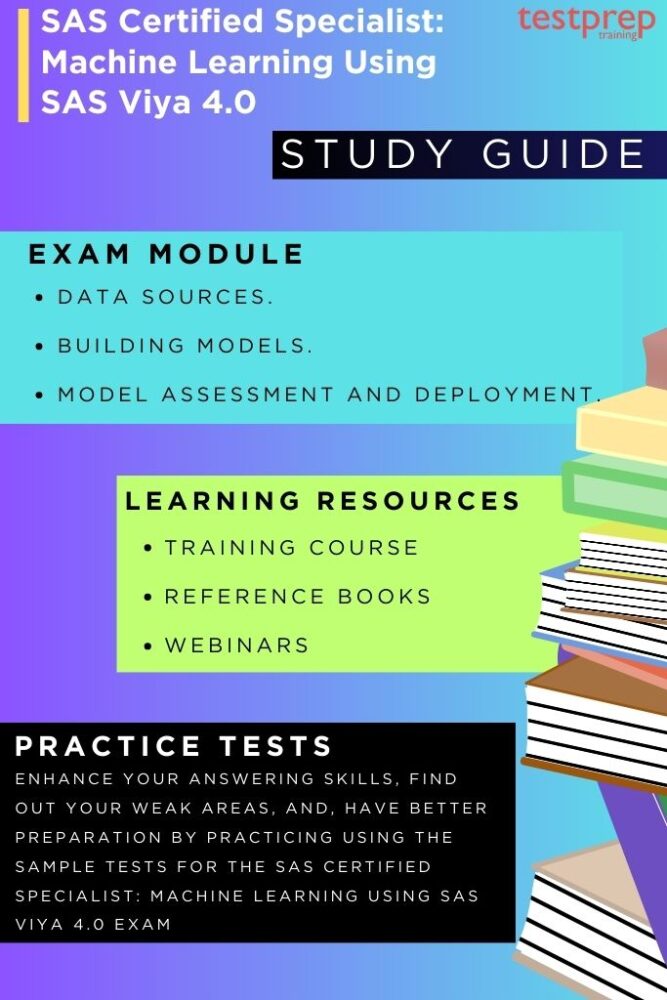
1. Understand the Exam Objectives
Thoroughly going through the course outline is crucial to getting ready for the exam, and making sure you cover everything you need to. Reviewing the exam objectives multiple times not only helps you understand the concepts faster but also boosts your confidence. Regularly revising keeps the information fresh in your mind, increasing your chances of doing well on the exam day. The objectives include:
- Data Sources.
- Building Models.
- Model assessment and deployment.
2. Use the SAS Exam Training Course
Machine Learning Using SAS® Viya®
This 14-hour course covers the basic theories behind supervised machine learning models. It uses practical demonstrations and exercises to help understand these concepts and how they can be used to solve business problems. Additionally, it includes a case study to guide participants through all stages of solving real-world problems using data analysis, from understanding the problem to deploying the model. This course is a key part of the SAS Viya Data Mining and Machine Learning curriculum. It focuses on Model Studio, a tool in SAS Viya for preparing, developing, comparing, and deploying advanced analytics models. You’ll learn how to train supervised machine learning models to make better decisions with big data.
In this course, you will learn how to:
- Implement the analytical life cycle to business needs.
- Solve business problems using analytical approaches.
- Explore data for building analytical models.
- Find the best features for predictive modeling.
- Create different types of supervised learning models, like decision trees, tree ensembles, neural networks, and support vector machines.
- Select the best model based on business requirements.
- Manage analytical models for production.
This course is suitable for business analysts, data analysts, marketing professionals, data scientists, and others working in related fields. Before taking this course, participants should have a basic understanding of statistics and machine learning concepts. Previous experience with SAS software is helpful but not necessary.
3. Use Reference Books
SAS Institute offers a helpful resource to help in your exam preparation: the first edition of the “Machine Learning with SAS Viya” book. This book provides detailed guidance on utilizing SAS Model Manager tools alongside open-source platforms. It highlights the features of SAS Model Studio to demonstrate machine learning processes within SAS Viya. The book also includes demonstrations, practice exercises, and quizzes to enhance your proficiency.
Within this book, you will explore:
- Supervised and unsupervised machine learning techniques.
- Strategies for preparing data and handling missing or unstructured data.
- Building and selecting models suited to your needs.
- Techniques for refining and optimizing models.
- Deployment of models and monitoring their performance over time.
4. Use Free SAS Certification Webinars
In the webinar, the specialists discuss the latest updates in the SAS certification offerings, showcasing how SAS has contributed to the career progression of analytics professionals and providing advice for initiating your certification journey. During the webinar, you’ll discover:
- The benefits a SAS certification brings to your organization.
- Strategies for persuading management about the significance of certification.
- The procedures SAS implements to safeguard certification authenticity and credibility.
- Information about newly introduced SAS certifications.
- Resources and support from SAS to aid in your exam preparation.
5. Take Practice Tests
Engaging in practice tests is an excellent strategy to enhance your preparation for exams. These tests simulate the exam environment and help you become familiar with the types of questions you may encounter. Additionally, they enable you to identify areas where you need more focus and gauge your readiness for the actual exam. Therefore, incorporating practice tests into your study routine can significantly improve your confidence and performance on the day of the exam.


